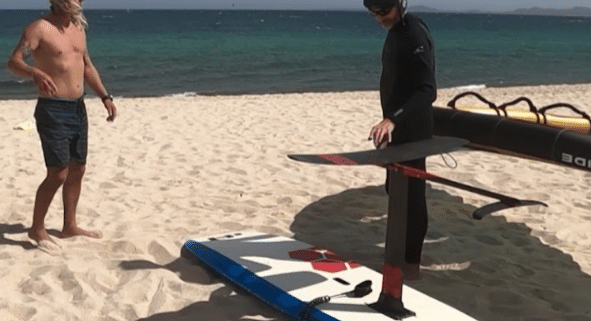Should I Kiteboard, Wingfoil or Windsurf in La Ventana?
Wingfoiling
Wing foiling has rapidly gained popularity as a thrilling water sport, and while kiteboarding and windsurfing each have their merits, wing foiling offers a unique set of advantages that might make it the perfect choice for your next aquatic adventure.
1. Simplicity and Portability: Wing foiling is known for its simplicity. Unlike kiteboarding, which involves managing lines, harnesses, and a large kite, or windsurfing, which requires handling a mast and sail, wing foiling relies on a compact, hand-held wing. This simplicity makes wing foiling more accessible to beginners and easier to transport. The lightweight equipment allows for easy travel, making it an excellent choice for those who want to explore different water environments without the hassle of bulky gear.
2. Versatility and Learning Curve: Wing foiling offers a relatively gentle learning curve, making it accessible to a wide range of enthusiasts. The absence of lines and the direct connection between the rider and the wing contribute to a more intuitive learning process. Unlike kiteboarding, where managing the kite can be challenging for beginners, wing foiling allows riders to focus more on the fundamentals of balance and board control. The compact nature of the equipment also makes it easier for riders to recover from falls and get back up on the board quickly.
3. Ride in Lighter Winds: Wing foiling is particularly advantageous in lighter wind conditions compared to kiteboarding and windsurfing. The wing generates lift even in lower wind speeds, allowing for a smooth and continuous ride. This can be a game-changer for individuals who frequent locations with inconsistent or lighter winds, providing the opportunity to ride when other water sports might be limited.
4. Foiling Experience: Wing foiling often involves the use of a hydrofoil, lifting the board out of the water and creating a sensation of flying above the surface. While foiling is possible in kiteboarding and windsurfing, the direct connection of the wing to the rider’s hands and the simplicity of the wing itself can make the foiling experience more accessible and enjoyable for many.
5. Safety and Independence: Wing foiling offers a higher degree of safety and independence. The absence of lines in the water reduces the risk of entanglement, making it a safer option, especially in crowded areas. Additionally, the hand-held wing allows riders to easily control and navigate their craft without relying on external elements like a kite or sail.
In conclusion, while kiteboarding and windsurfing have their merits, wing foiling distinguishes itself through its simplicity, versatility, accessibility, and the unique foiling experience it offers. Whether you’re a seasoned water sports enthusiast or a beginner seeking a new adventure, wing foiling provides an exciting and rewarding alternative to traditional wind-driven water activities.
Kiteboarding
Kiteboarding, a dynamic and exhilarating water sport, stands out for several reasons that make it arguably superior to wing foiling and windsurfing in various aspects. Here are some key advantages that showcase why kiteboarding might be the preferred choice for many enthusiasts.
1. Power and Speed: Kiteboarding is renowned for its unmatched power and speed. The use of a large controllable kite allows riders to harness strong winds effectively, providing a thrilling experience with high speeds and impressive jumps. While wing foiling and windsurfing can be exhilarating, kiteboarding’s ability to generate significant power and acceleration sets it apart as an adrenaline-fueled water sport.
2. Aerial Maneuverability: Kiteboarding offers unparalleled aerial maneuverability, allowing riders to execute impressive jumps, spins, and tricks. The combination of a dynamic kite and a maneuverable board enables riders to perform acrobatic feats that are challenging to replicate in wing foiling or windsurfing. The freedom to explore the three-dimensional space above the water adds an extra layer of excitement to the sport.
3. Range of Conditions: Kiteboarding excels in a wide range of wind conditions. From light breezes to strong gusts, kiteboarders can adapt to varying wind strengths with different kite sizes, making it a versatile choice for locations with inconsistent or changing wind patterns. In comparison, wing foiling and windsurfing may have limitations in extremely light or strong winds.
4. Independence of Movement: Kiteboarding allows for greater independence of movement, as riders can control the kite and board separately. This separation enables more dynamic and responsive maneuvers, offering a level of control and versatility that may be challenging to achieve in wing foiling and windsurfing. The ability to depower the kite quickly also enhances safety and control in challenging conditions.
5. Freestyle and Tricks: Kiteboarding’s freestyle aspect is a major draw for riders seeking an adrenaline-pumping experience. The sport’s progressive nature encourages riders to continually push boundaries and invent new tricks. The combination of kite control, board skills, and aerial possibilities creates a platform for continuous innovation and excitement that may be less pronounced in wing foiling and windsurfing.
6. Established Community and Infrastructure: Kiteboarding boasts a well-established global community and infrastructure with numerous schools, events, and dedicated spots worldwide. This accessibility makes it easier for beginners to learn the sport, find experienced instructors, and connect with like-minded enthusiasts. While wing foiling is gaining popularity, kiteboarding’s long-standing presence provides a more mature and supportive ecosystem.
In conclusion, while personal preferences and individual goals play a significant role in choosing a water sport, kiteboarding stands out for its unparalleled power, aerial maneuverability, adaptability to various wind conditions, and the established community that surrounds it. For those seeking an adrenaline-charged experience with a wide range of possibilities, kiteboarding remains a top choice in the realm of wind-driven water sports.




